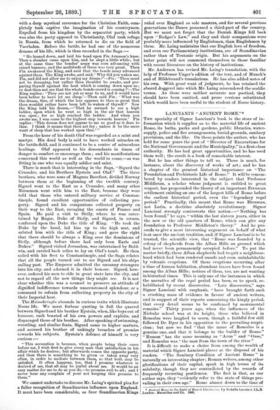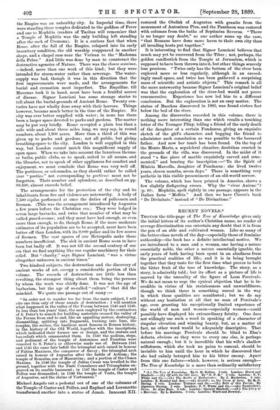LANCIANI'S "ANCIENT ROME."*
Tun specialty of Signor Lanciani's book is the store of in- formation which it supplies as to the material life of ancient Rome, its baths, parka and gardens, public libraries, water- supply, police and fire arrangements, burial-grounds, sanitary provisions, and the like. On these points the author, who has held for some years the post of " Director of Excavations for the National Government and the Municipality," is a first-class authority. He has had great opportunities, and he has used them well ; the result is a book of remarkable interest.
But he has other things to tell us. There is much, for instance, about the discovery of works of art ; and he has a chapter of the greatest historical importance on " The Foundation and Prehistoric Life of Rome." It will be remem- bered by readers interested in the subject that Professor Middleton, a scholar whose judgment is entitled to great respect, has propounded the theory of an important Etruscan settlement existing on one of the largest hills of Rome before the earliest historical period, even the " legendary regal period." Practically, this meant that Rome was Etruscan, not Latin, a doctrine absolutely revolutionary. Signor Lanciani strongly controverts this notion :—" Nothing has been found," he says, " within the last sixteen years, either in the new or the old quarters of Rome, which can give any foundation to Professor Middleton's theory." And he pro- ceeds to give a most interesting argument on behalf of what is at once the ancient tradition, and, if Signor Lanciani is to be trusted, the scientific view, that "Rome was founded by a colony of shepherds from the Alban Hills on ground which had never been permanently occupied before." To put the matter briefly, these Alban shepherds had to quit a neighbour- hood which had been rendered unsafe and even uninhabitable by volcanic eruptions. Of these eruptions occurring after a time of human habitation, abundant traces have been found among the Alban Hills ; notices of them, too, are not wanting in historical times. This is only one of the instances in which the narrative of the regal period has been, so to speak, re- habilitated by recent discoveries. "Late discoveries," says Signor Lanciani with emphasis, " have brought forth such a crushing mass of evidence in favour of ancient writers, and in support of their reports concerning the kingly period, that every detail seems to be confirmed by monumental remains." Thirty years ago, when the influences of the Niebuhr school was at its height, those who believed in Romulus were laughed to scorn, though a faithful few still followed Dr. Dyer in his opposition to the prevailing scepti- cism ; but now we find " that the name of Romulus is a genuine one, and that it belongs to the builder of Rome." " Rumon " has the same meaning as " Avon " and " Ouse," and Romulus was " the man from the town of the river."
It is difficult to make a choice from among the wealth of material which Signor Lanciani places at the disposal of his readers. " The Sanitary Condition of Ancient Rome " is
naturally an interesting chapter; Roman writers, among other glorifications of their capital, speak in high terms of its salubrity, though they are contradicted by the records of
frequently recurring pestilences. The fact is that, as our author says, they "evidently refer to the state of things pre- vailing in their own age." Rome almost down to the time of * Ancient Rome in the Light of &telt Diirove:ice. By Rodolfo Lnneiani, LL.D. London: Macmillan and Co, 1M.
the Empire was an unhealthy city. In Imperial time, there were standing three temples dedicated to the goddess of Fever and one to Mephitis (readers of Tacitus will remember that a Temple of Mephitis was the only building left standing after the sack of Cremona). It is a curious fact that when Rome, after the fall of the Empire, relapsed into its early insanitary condition, the old worship reappeared in another shape, and a chapel rose near the Vatican to the " Madonna della Febre." And little was done by man to counteract the destructive agencies of Nature. There was the cloaca maxima, —indeed, more than one work of this kind ; but they were intended for storm-water rather than sewerage. The water- supply was bad, though it was in this direction that the first improvements were made, and the arrangements for burial and cremation most imperfect. The Esquiline, till Mweenas took it in hand, must have been a fruitful source of disease. Signor Lanciani has some strange stories to tell about the burial-grounds of Ancient Rome. Twenty cen- turies have not wholly done away with their horrors. Things however, became much better in the time of the Empire. No city was ever better supplied with water ; in none has there been a larger space devoted to parks and gardens. The matter may be put very briefly. Rome occupied a plain less than a mile wide and about three miles long, we may say, in round numbers, about 1,800 acres. More than a third of this was given up to parks and gardens ; not all public, but giving breathing-space to the city. London is well supplied in this way, but London cannot match this magnificent supply of open space. When we take into account the luxurious therms' or baths, public clubs, so to speak, suited to all means, and the libraries, not to speak of other appliances for comfort and enjoyment, we must conclude that Rome was very well off.
The porticoes, or colonnades, as they should rather be called (our " portico " not corresponding to porticus) must not be forgotten. Their number and splendour, as described on pp. 98-100, almost exceeds belief.
The arrangements for the protection of the city and its inhabitants from fire and violence are noteworthy. A body of 7,500 vigiles performed at once the duties of policemen and firemen. (This was the arrangement introduced by Augustus a few years before the Christian era.) They were lodged in seven large barracks, and twice that number of what may be called guard-rooms ; and they must have had enough, or even more than enough, to do, though Rome, if the more moderate estimates of its population are to be accepted, must have been better off than London, with its 9,000 police and its few scores of firemen. The vast spaces of our Metropolis make these numbers insufficient. The sick in ancient Rome seem to have been but badly off. It was not till the second century of our era that we find anything like our regular machinery for their relief. But " charity," says Signor Lanciani, " was a virtue altogether unknown in ancient times."
Two kindred subjects, the destruction and the discovery of ancient works of art, occupy a considerable portion of this volume. The records of destruction are little less than revolting, the strangest thing about them being the persons by whom the work was chiefly done. It was not the age of barbarism, but the age of so-called " culture" that did the mischief. We quote one passage out of many :— " In order not to wander too far from the main subject, I will cite one item only of these annals of destruction : I will mention what happened in the valley of the Forum between 1540 and 1549. In less than ten years' time, the men employed by the contractors of S. Peter's to search for building materials crossed the valley of the Forum from end to end, like an appalling meteor, destroying, dismantling, splitting into fragments, burning into lime, the temples, the arches, the basilicas most famous in Roman history, in the history of the Old World, together with the inscriptions which indicated their former use or design, and the statues and bas-reliefs which ornamented them. In 1540 the podium, steps, and pediment of the temple of Antoninus and Faustina were removed to S. Peter's or otherwise made use of. Between 1541 and 1545 the same fate befell the triumphal arch raised in honour of Fabius Maximus, the conqueror of Savoy ; the triumphal arch raised in honour of Augustus after the battle of Actium ; the temple of Romulus, son of Maxentius ; and a portion of the Cloaca Maxima. In 1546 the temple of Julius Caesar was levelled to the ground, together with the Fasti Consulares and Triumphalee en- graved on its marble basement ; in 1547 the temple of Castor and Pollux was dismantled ; in 1549 the temple of Vesta, the temple of Augustus, and the shrine of Vortumnus."
Michael Angelo cut a pedestal out of one of the columns of the Temple of Castor and Pollux, and Raphael and Lorenzetto transformed another into a statue of Jonah. Innocent XII. restored the Obelisk of Augustus with granite from the monument of Antoninus Pius, and the Pantheon was restored with columns from the baths of Septimias Severna. " There is no longer any doubt," so our author sums up the case, " that Romans have done more harm to their own city than all invading hosts put together."
It is interesting to find that Signor Lanciani believes that much may yet be recovered from the Tiber ; not, perhaps, the golden candlestick from the Temple at Jerusalem, which is supposed to have been thrown into it, but other things scarcely less precious. " Twice only has the bottom of the river been explored more or less regularly, although in an exceed- ingly small space, and twice has been gathered a surprising mass of scientific and artistic objects." This remark is all the more noteworthy because Signor Lanciani's original belief was that the exploration of the river-bed would not prove remunerative. Experience has now led him to a different conclusion. But the exploration is not an easy matter. The statue of Bacchus discovered in 1885, was found sixteen feet below the bed of the river.
Among the discoveries recorded in this volume, there is nothing more interesting than one which recalls a touching letter of the Younger Pliny, telling a friend of the early death of the daughter of a certain Fundanus, giving an exquisite sketch of the girl's character, and begging the friend to administer such consolation as was possible to the bereaved father. And now her tomb has been found. On the top of the Monte Mario, a sepulchral chamber, doubtless erected in the grounds of the villa, was discovered. In the midst of it stood "a fine piece of marble exquisitely carved and orna- mented," and bearing the inscription :—" To the Spirit of Minicia Marcella, daughter of Fundanus ; she lived twelve years, eleven months, seven days." There is something very pathetic in this visible presentment of an old-world sorrow.
The volume, which has been printed in America, shows a few slightly disfiguring errors. Why the "river Aniene " (p. 60). Mephitis, spelt rightly in one passage, appears in the Italian form " Mefitis." And then we have Cicero's book " De Divinitate," instead of "De Divinatione."







































 Previous page
Previous page